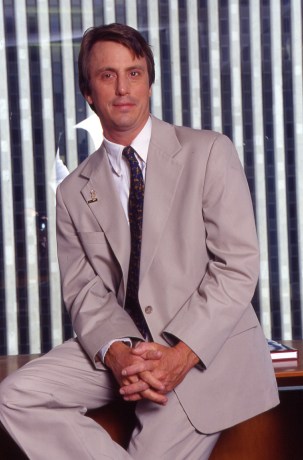Charles Riley never expected a career in the art world.
Riley, the new director of the Nassau County Museum of Art, has a Ph.D. in English literature from the City University of New York and began writing short essays for artists’ gallery shows to help people understand the artist’s vision.
He grew up in Manhasset and worked as a Time Inc. reporter covering the art market and Washington, D.C., for Fortune Magazine. When Riley was editor of Art and Auction, he said he realized the money side of art wasn’t his passion, and he focused on celebrating artists.
“The artist has the primary word,” Riley said. “When I would do a catalogue essay or do a show, I would say, ‘What are your intentions? What were you thinking?’ Before I start laying on my guesses and projecting my own feelings about your work and who you are, I would always let the artist have the first say and the final say.”
Though new to the job, Riley said he has a number of ideas and aspirations for his first year as leader of the museum. Riley recently published his 32nd book on art, “Free as Gods: How the Jazz Age Reinvented Modernism,” and said he would love to bring a Jazz Age show to the museum.
He said he was eager to begin announcing new exhibits and events but had not yet met with various committees and trustees to finalize details.
Among Riley’s books is “Color Codes: Modern Theories of Color in Philosophy, Painting and Architecture, Literature, Music, and Psychology,” which examines the way different professions look at colors.
“When I walk around the museum, I’m very drawn to old masters,” Riley said. “I spent a lot of my time working on color and color theory, so I’ve always been very taken by not just the impressionists, who I think were among the great colorists, but also the Fauves.”
Fauvism is a group of early 20th-century modern artists whose works emphasized strong color over the realistic values retained by impressionism.
As a former professor for 30 years at CUNY and Clarkson University in Potsdam, Riley has a love for teaching and wants to educate everyone on the beauty of all kinds of art, from the classics to contemporary and everything between.
“I like learning in public. I love learning not just about art but about the way art relates to the time and to its place,” Riley said. “All my enthusiasm is genuine, and it’s the enthusiasm for something that seems new and fascinating.
“When I pick up a book about art, I’m fascinated because I’m learning. Visitors who come who are also learning will enjoy some of that, just learning with me.”
Throughout his career, Riley has befriended a number of artists and said he admires their unique take on the world and their ability to express that view physically.
“I love going to studios. I never know what I’m going to see. I love the mode of thinking,” Riley said. “It’s so different from the business world and the journalistic world or the academic world, and my enthusiasm for that is completely genuine. I don’t want to make all artists into heroes, but I really do admire them and their place in our society.
“This is something I maybe put up on a pedestal a little bit, but I want my love of that to be conveyed to my visitors.”
Riley, 59, said while he is thrilled with the new position, he was not looking for a job.
“When [the position was offered], it came at precisely the right time in my life. I’m old, and my days in the classroom have been wonderful. There was a good 30-plus years in that, and I was ready for a change,” Riley said. “I know this museum really well. I’ve lectured here, I’ve curated here, I’ve come here as a Nassau County resident. When they said they could use me, I was delighted to say ‘use me!'”
Riley’s predecessor, Karl Willers, directed the museum for seven years and is credited with helping recently open the new Manes Family Art and Education Center. The museum has declined to say what led to his departure.
Riley recently lost his mother, Isabel, and said he often sees her kind spirit in the volunteers and docents and knows he’s taking the right path.
“I’m doing what my mom taught me to do, which is recognize the power of art and say thank you in the place where I grew up,” he said.

